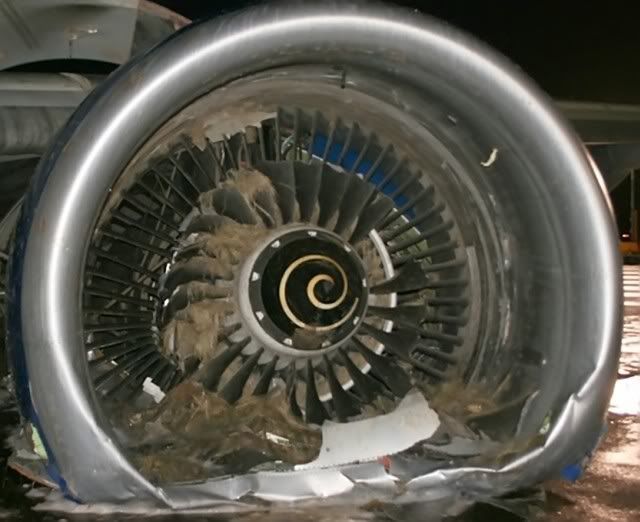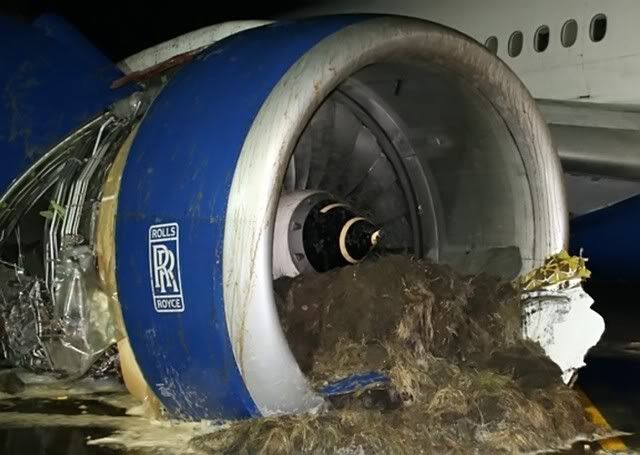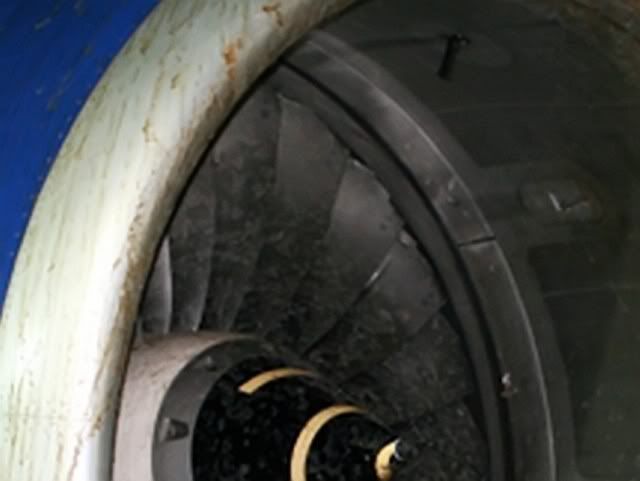You are using an out of date browser. It may not display this or other websites correctly.
You should upgrade or use an alternative browser.
You should upgrade or use an alternative browser.
777 down.
- Thread starter empip
- Start date
- Status
- Not open for further replies.
what, with an airspeed over the wing of zero?
The aircraft will take off as normal, the wheels will spin at whatever speed they need to, for this to happen.
The aircraft gets its thrust from the air not the ground.
Remember the wheels are not driven.
Trazor is correct, the wheels have nothing to do with this and are only there to support the aircraft whilst its on the ground 
Engines produce thrust, aircraft moves forward and once there is sufficient airflow across the wings the aircraft is airborne.
Doesn't matter whether the aircraft is on wheels, skids or dragging along on its belly (assuming there is enough thrust to overcome the drag).
MW
Engines produce thrust, aircraft moves forward and once there is sufficient airflow across the wings the aircraft is airborne.
Doesn't matter whether the aircraft is on wheels, skids or dragging along on its belly (assuming there is enough thrust to overcome the drag).
MW
The plane won't take off because the reverse speed of the conveyor belt automatically matches the forward speed of the plane.
This conveyor belt has a control system that tracks the aircraft's wheels speed and tunes the speed of the conveyor belt to be exactly the same as the wheels, but in the opposite direction.
So the plane rolls forward relative to the belt, but the belt moves the plane backwards by the same amount and the plane remains stationary relative to the air.
This conveyor belt has a control system that tracks the aircraft's wheels speed and tunes the speed of the conveyor belt to be exactly the same as the wheels, but in the opposite direction.
So the plane rolls forward relative to the belt, but the belt moves the plane backwards by the same amount and the plane remains stationary relative to the air.
Go away and think about what you've just posted 
If you want to try something out ... Take a model aircraft with you next time you go shopping and try it on the conveyor.
Irrespective of how fast the conveyor moves towards you the plane will still move forward at the speed you push it.
Different scenario if you put the brakes on though but we must assume that the brakes are off for takeoff
MW
If you want to try something out ... Take a model aircraft with you next time you go shopping and try it on the conveyor.
Irrespective of how fast the conveyor moves towards you the plane will still move forward at the speed you push it.
Different scenario if you put the brakes on though but we must assume that the brakes are off for takeoff
This could only happen if the brakes are on.So the plane rolls forward relative to the belt, but the belt moves the plane backwards by the same amount and the plane remains stationary relative to the air.
MW
Go away and think about what you've just posted
MW
I have thought about it.
Someone posted in the other thread 'Wheels or no wheels a force is pushing the friggin thing forward' Making the mistaken assumption that there is nothing pushing back. Like rolling resistance which will increase with the rotational speed of the wheels.
- Joined
- 24 Sep 2005
- Messages
- 6,345
- Reaction score
- 269
- Country

If you were interested in flight ...
http://www.dfrc.nasa.gov/Education/OnlineEd/NewtonsLaws/index.html
has to be one of the best free resources on the world wide web !!

http://www.dfrc.nasa.gov/Education/OnlineEd/NewtonsLaws/index.html
has to be one of the best free resources on the world wide web !!
It is a good site Empip though it does over simplify many things which creates inaccuracies for the purist 
One such instance is ...
There is, in fact, no "explosion" in a gas turbine, the air/fuel mixture is simply ignited and held as a constant flame on the burner ring within the combustion chamber ... The more fuel you add, the more heat (and thus energy) is produced which spins the turbine(s) faster producing more thrust at the fan which is connected at the other end of the LP spool shaft.
Artistic licence though by the authors to put the point across and doesn't diminish from the site at all.
Blondini wrote:
If you are serious I suggest you set up a simple experiment to investigate as I've suggested as, I can assure you, the aircraft will take off as normal and the pilot wouldn't notice any difference. The only physical difference will be the wheel rotational speed which will be the sum of the normal speed plus the speed generated by the conveyor.
MW
One such instance is ...
This densely packed air/fuel mixture is ignited and the resultant "explosion" accelerates the gases out the rear of the engine at a very high rate of speed.
There is, in fact, no "explosion" in a gas turbine, the air/fuel mixture is simply ignited and held as a constant flame on the burner ring within the combustion chamber ... The more fuel you add, the more heat (and thus energy) is produced which spins the turbine(s) faster producing more thrust at the fan which is connected at the other end of the LP spool shaft.
Artistic licence though by the authors to put the point across and doesn't diminish from the site at all.
Blondini wrote:
Hmmmmnnnn I'm hoping you're just having a laugh now, or perhaps you're ****edSomeone posted in the other thread 'Wheels or no wheels a force is pushing the friggin thing forward' Making the mistaken assumption that there is nothing pushing back. Like rolling resistance which will increase with the rotational speed of the wheels.
If you are serious I suggest you set up a simple experiment to investigate as I've suggested as, I can assure you, the aircraft will take off as normal and the pilot wouldn't notice any difference. The only physical difference will be the wheel rotational speed which will be the sum of the normal speed plus the speed generated by the conveyor.
MW
I always thought that a "combustion chamber" is where the fuel/air mixture usually highly compressed is ignited and explodes, in a normal combustion engine this force is used to push a piston, in the gas turbine the hot expanded gas forces its way out the back of the turbine, via other blades that in turn drive the front fan also which helps suck more air in to continue the cycle.
B
Barsteward
That's the Navy bolloxed with the Aircraft carriers thenGo away and think about what you've just posted
MW
I have thought about it.
Someone posted in the other thread 'Wheels or no wheels a force is pushing the friggin thing forward' Making the mistaken assumption that there is nothing pushing back. Like rolling resistance which will increase with the rotational speed of the wheels.
Isnt that adding another problem to the equation, dont they go up and down aswell with the wavesThat's the Navy bolloxed with the Aircraft carriers thenGo away and think about what you've just posted
MW
I have thought about it.
Someone posted in the other thread 'Wheels or no wheels a force is pushing the friggin thing forward' Making the mistaken assumption that there is nothing pushing back. Like rolling resistance which will increase with the rotational speed of the wheels.
- Status
- Not open for further replies.



